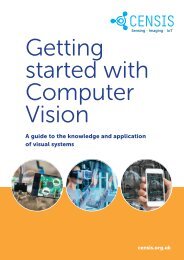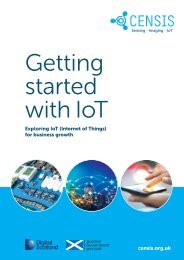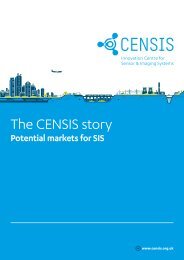CENSIS white paper: Intellectual Property in Business
2023: This CENSIS white paper sets out to make the topic of IP more approachable, less intimidating and more manageable, offering experience-based advice and methods are are designed to help businesses structure their IP- related issues and makes the best of their IP. Covering: The role of IP, IP management during growth, IP strategy for expanding companies and corporates, Business IP Canvas - merging IP with your business model.
2023: This CENSIS white paper sets out to make the topic of IP more approachable, less intimidating and more manageable, offering experience-based advice and methods are are designed to help businesses structure their IP- related issues and makes the best of their IP.
Covering:
The role of IP, IP management during growth, IP strategy for expanding companies and corporates, Business IP Canvas - merging IP with your business model.
You also want an ePaper? Increase the reach of your titles
YUMPU automatically turns print PDFs into web optimized ePapers that Google loves.
<strong>Intellectual</strong> <strong>Property</strong> <strong>in</strong> Bus<strong>in</strong>ess: IP basics, IP management, IP strategy<br />
IP Management dur<strong>in</strong>g Growth (cont<strong>in</strong>ued)<br />
Given such litigation threats, it is reasonable to assume<br />
that OEMs and retailers do scrut<strong>in</strong>ise more carefully<br />
any offer<strong>in</strong>gs of the component suppliers and do<br />
pay attention that IP rights are respected s<strong>in</strong>ce they<br />
happen to be more exposed to patent litigations than<br />
before. However, this does not mean that suppliers<br />
can shrug their shoulders and avoid repercussions. On<br />
the contrary, it is to be expected that targeted OEMs<br />
will confront their suppliers. After all, contracts <strong>in</strong>clude<br />
elements such as liability, <strong>in</strong>surance, warranties and<br />
IP, so they will likely reimburse OEMs for patent/IP<br />
<strong>in</strong>fr<strong>in</strong>gements.<br />
What do such shifts <strong>in</strong> litigation practices mean <strong>in</strong><br />
terms of IP strategy? At least two aspects should<br />
be considered: IP risk assessment and licens<strong>in</strong>g/<br />
commercial strategies.<br />
With regard to IP risk assessment, understand<strong>in</strong>g the<br />
dynamics <strong>in</strong> the supply cha<strong>in</strong> of the addressed market is<br />
crucial when negotiat<strong>in</strong>g contracts with suppliers and/<br />
or retailers. Indemnity clauses are of particular concern<br />
when it comes to any lawsuits and repercussions<br />
for tier-suppliers. Such clauses def<strong>in</strong>e the supplier’s<br />
responsibility aga<strong>in</strong>st the buyer (retailer, OEM) and<br />
can oblige the manufacturer to pay (or participate <strong>in</strong>)<br />
trial costs and damages. In addition, more attention is<br />
be<strong>in</strong>g paid to ethical conduct with IP rights. Therefore,<br />
all stakeholders of the supply cha<strong>in</strong> should be diligent<br />
about respect<strong>in</strong>g IP rights. In terms of strategic actions,<br />
implement<strong>in</strong>g proper IP policies can ensure that goods<br />
are manufactured and shipped with a lower risk of IP<br />
<strong>in</strong>fr<strong>in</strong>gement. 54<br />
With respect to licens<strong>in</strong>g strategy, the analysis of<br />
the supply cha<strong>in</strong> should shed more light on the best<br />
licens<strong>in</strong>g opportunities <strong>in</strong> terms of royalties. The closer<br />
towards the OEM, the more the higher prices of the<br />
components <strong>in</strong>fluence the royalty rate, up to the f<strong>in</strong>al<br />
commercial unit.<br />
This, however, does not mean that a Tier 1 supplier<br />
will license the components to an OEM and receive<br />
royalties. The supply contract can <strong>in</strong>clude licences<br />
from Tier 2/3 suppliers, but it might be a ‘simple’ sale<br />
transaction between the Tier 1 supplier and the OEM.<br />
Every market has own peculiarities, and it is extremely<br />
important to understand these – for example, what<br />
the transactions between suppliers and buyers <strong>in</strong> each<br />
tier look like (licens<strong>in</strong>g, sales), which licens<strong>in</strong>g fees are<br />
common among the addressed <strong>in</strong>dustries, and whether<br />
the <strong>in</strong>dustry respects IP rights.<br />
54<br />
Giler (n 51).<br />
34

















